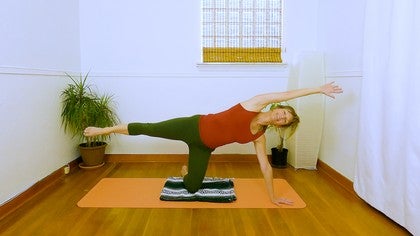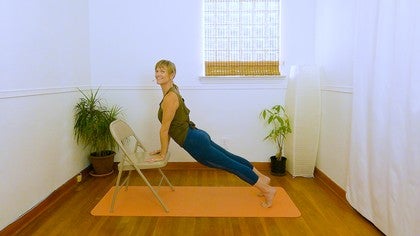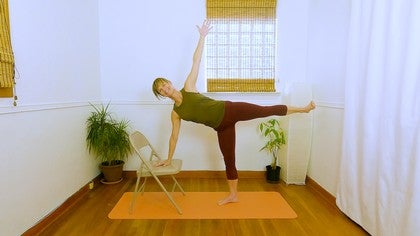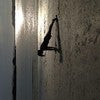Description
About This Video
Transcript
Read Full Transcript
Hi, I'm Allie Greene and this is class three of Move into Ease. We're going to explore embodying our breath today. The only prop you'll need, or maybe you won't, is going to be a blanket. We're gonna be sitting on this and then we're also gonna be doing some kneeling exercises. So, I love having something underneath my knees.
If you do too, just have it nearby and we'll grab it. So, if you'd like to sit on one, you can join me. So, we breathe all day long, but we rarely notice the quality of our breath or where we feel it or even more interestingly, where we don't. In this class, we are going to explore our breath, our lungs, and even the diaphragms as movement and support. So, for our pre-practice observation, I invite you to close your eyes and begin to notice your breath.
Let's notice the inhale first. What does your inhale feel like? Is it a long inhale? Is it short? Does it feel thin or full?
And remember, whatever you feel is real and it's totally okay. We're not really changing anything right now we're just simply observing. And we always wanna be kind to ourselves when we do this compassionate and also practice our non-judgment. Now I invite you to notice your exhale. Same thing.
Where do you feel it in your body Or where don't you? Is it full? Is it smooth or does it have any stops and starts? Now I invite you to notice that between your inhale and your exhale, there's a pause. It's as if your breath is just rounding the corner.
How long is that pause? What does it feel like? What do you feel when you notice it? And same thing between the exhale and the inhale. So, we have this beautiful loop of breath and you can just keep following that.
Now, if you found some things that you thought, hmm I might wanna change that, go ahead and do it. If you wanna make one of your breaths a little longer or maybe change the quality of it or play around with it. Our breath is deeply connected to our nervous system. Our inhale is connected to the sympathetic, the action part of the nervous system. Many times it gets just connected to fight, flight but we need some action.
So, fight, flight is on the end of that. And our exhale is connected to our parasympathetic nervous system, our rest and digest. And we really wanna be in the middle with that too because on the end of that is a coma. So, we don't wanna be on the ends. We wanna find that beautiful middle ground and let that interweave.
It creates support and centering. Our restfulness has potential and potency underneath it. So, if we need to move out into the world or to do something, we're ready for it. And our inhale has some groundedness to it. So, our action has some rootedness and groundedness to it.
Beautiful balance. Now we're going to do an embodied anatomy practice. We have when we approach it in an embodied way we have three lobes of the lungs on each side. Now, if you are going to open an anatomy book left is only gonna have two and the right will have three. And that's 'cause of our beautiful heart.
But when we are embodying the breath because of what's happening inside those lobes of the lungs there is very much the sensation and the support of having two upper, two middle and two lower lobes of the lungs. So, we are gonna take our hands, cross them over right above your collarbone, come a little bit more in towards the neck and just continue to feel your breath. Your hands are resting on the upper lobes of the lungs and they offer support for the neck and head. So, we can think about this when we're in these slump postures or little forward head. We can use our muscles to create better posture or we can move deeper inside of ourselves and have our organs be a source of support.
Now I also really love practicing my exhale with my upper lobes because they are deeply connected to everything. And so as I exhale, and see if you feel it too, what I feel is that my shoulders follow my muscles, my bones, my tissues. They follow and they soften and relax. So, just try a few more of those. Now we're gonna move to the mid lobes.
We can cross our arms and put them right in our armpits. And it's really the chest area. So, the mid lobes are a little bit more front and let's breathe into those mid lobes. They move a little differently. I was feeling that my upper lobes moved more up and down.
Now I'm feeling like these mid lobes move a little bit more out to the side and in. And that's my experience. So, if you're having a different experience that's just as valid, just as real. So, the mid lobes create support for the arms, for the shoulders. We're also creating a lot of movement through our breath.
So, our tissues of breathing, our joints are expanding and condensing. Let's take one more round of breath and then we're gonna move to the lower lobes. Lower lobes, I'm gonna turn so you can see, they start right at the bottom of your shoulder blade and they go all the way down to the bottom rib and they're very much in the back, really long. So, if it's comfortable, you can put your hands in the back like this. If that's not comfortable for a shoulder, you can just bring the hands in the front and just know that this touch is informing your back body.
So, what does it feel like to breathe into these lower lobes? When I breathe into my lower lobes, I feel as if they fill and move downwards giving support to the lower back and my pelvis. Just take two more rounds of breath. This could be a practice you could do for half an hour. So, these are little samplers in this class.
Now, what if we kept one hand on the lower lobe of the lung and we took the other hand crossed it over to the upper lobe and can you feel how much room that's taking up? That's a lot of support. And let's just breathe. And when you're ready, you can just let the hands come down continuing that breath. And now you have an awareness of these lobes.
So, the lungs no longer are feeling like bellows. They're this like beautiful symphony of all this different movement. And as we're breathing and moving these lungs, we have amazing diaphragms. One runs right across here, another one's the pelvic floor. We did all those beautiful pelvic circles in the last class.
We even have a diaphragm here, roof of the mouth, even the crown of the head. So, as the lungs are expanding and condensing, I invite you to see if you can just notice all of that. It's a lot to notice. So, you can always just pick one thing and then pick another thing. The more we consciously embody ourselves, the more balance we create in the body and the more choice we give to ourselves.
More balance, more choice, more ease. Now let's have our lungs initiate some movement. You can use your breath for this. You can exhale and inhale, or you can simply let your breath breathe. Let's begin with flexing and extending.
So, moving downwards, the lungs are emptying, they're condensing and everything is following inwards. And then the lungs can fill and expand and everything is following. And let's do that a few more times. So, all these movements that we're gonna do in this embody your breath class. I bet you already know them.
But remember we're creating choice. So, we can experience a flexing and extending with our muscles, with our bones and today with our organs, our lungs, our breath. One more time. Condensing inwards. This beautiful sponging. And where are we going? Center.
And where are we moving away from? Center. Taking a pause in the center, we can find the pelvic floor. What if we do little side bending? Now, this gets interesting. Our lungs are paired organs so this side can do this condensing.
This side can use that as support and do expanding. And then this can expand and bring you up. Over to the other side. Condensing, expanding. And so it really doesn't matter which breath goes where it's where your attention goes.
Do you wanna focus on maybe an exhale and feel that condensing? I'd like to feel a little bit more grounded. Or maybe you wanna focus on the inhale, feel more expanding. I'd like a little bit more energy, little bit more action. No, I think I wanna feel a little bit more rest, digest or I just wanna feel both.
I just wanna find a little balance. Feel pretty, pretty good today. So, just feeling that the lungs can create movement for us. They can initiate movement. And what if we were to explore that in rotation?
So, here we have this center started with naval radiating pattern, moved to more of that verticality and our lungs are spiraling around. One is spiraling to the back and the other is spiraling around the front. And then returning. And we can do that the other way. Now the beautiful thing about moving from our organs is that is really center.
So, if our joints are following the support of center they are really super safe because they're supported. You could make this spiral a little bit bigger. And again, what is it that you wanna focus on? You wanna take an inhale and feel the expanding or would you like to focus on the exhale and feel that condensing. And then return right back to center.
Ah, we're going to get onto hands and knees. Remember we're slowly coming up away from the floor but built this support from the ground up. So, here is where I like to put my blanket under my knees. Support. Our knees can go right under the hips.
Our hands are actually gonna go a little bit in front of the shoulders, not a lot, just a little bit. So, that what we can feel is the push of the hands and how that energy flows right up into the center. And that is through those lungs. We're gonna do a cat cow. Let's initiate with the lungs.
So, we can take an exhale and those lungs are condensing, they're drawing everything in, everything's following. And then an inhale. Now as we inhale and move into this extension, those lower lobes of the lungs are a beautiful source of support there. And exhaling, emptying, condensing, like little sponge squeezing. There's those upper lobes supporting the neck and the head.
Same thing as you go into that extension, mid lobe supporting the arms. One more time, nice little push, yield and push whatever's in relationship to the ground. Reach and pull whatever's in relationship to space and nice inhale, lungs, support. Bring yourself back just to center. Let's do a little thread the needle.
So, taking that right arm, it's gonna slide underneath. Here's our relationship. Hand through the arm through the shoulder to that right lung and you can go a little bit, you could go a lot. What does your body need today? Maybe it doesn't need a big twist, even if you can do it.
And then return back up. And now we could follow the left hand push all the way up. That push goes into the left lung and then that travels through the center to the right with a beautiful reach. And return. Let's explore that on the other side.
So, we take that hand and slide it through following the rotation of those lungs around the center, softening into the support of the ground, space is there supporting you. And a push with that left hand yield push travels right through the center to a reach and pull. And it's the lungs that spiral around. And then return. Now we're gonna make this a little fancier because I like to make things fancy sometimes. (chuckles) Let's take the left leg out.
This has a beautiful curve to the the foot. It's a spiral. It's like a beautiful little tap root. Let's take the left arm out to the side yield, move towards support, push, move away from support. Lung spiraling around lung spiraling around.
And we're gonna go into a thread, the needle here gonna send it through all that space supporting you. And then we have a choice, we could stay here. We could also go a little further down and use the forearms support and reach that right arm further out and keep going. Lung spiraling around the center, just feeling your breath. Let your breath breathe.
Organizing around that center, coming back out of this sliding back over. Have that forearm there for your support. Slide that right arm back in to push. And can we open one more time. Expanding out into space, soft.
And then return. And we can do that on the other side. So, let's take the right leg out find that beautiful tap root flow the right arm out, yield and push, moves through the center, flows out all our limbs. Lungs are spiraling around the center. And then travel back through space.
Thread the needle through. Take a little pause here And choice. Do I wanna just stay here or would I like to put my forearm down take my left hand further out and continue the journey. Always checking in with support. And then coming back up out of that forearm is the push to support left arm can come back in and yield.
Push from the ground reach, pull through space. Feel the difference in the tone of what is pushing away from the ground and what is reaching through space. Lung spiraling around that center. And then we'll return. Let's bring the leg in and have a seat.
Now, the next practice we're gonna be kneeling. If this is not a comfortable position for you, you can certainly do this seated with your legs crossed. You can do this Seated in a chair, it doesn't make it any less. So, we're going to do a lovely little exhale to take us into this flexed position. Condensing inwards to the front, expanding outwards to the back.
And then yield, push from the legs and they're slightly apart. Lungs can expand, arms can flow out from the lungs. Let your shoulders glide and slide. The lungs are supporting our shoulders. We can let those shoulder muscles take a vacation.
And then emptying. You could do an exhale, you could do a big exhale or a soft exhale. We wanna watch if our breath is a very muscular breath 'cause it could put more tension in the body. Can be interesting to experiment with different qualities of breath. And we just take a breath in here.
You could even inhale more in the right and see if you can reach that right arm up more. And what if you inhaled more through the left? Maybe we do that one more time each side. And what's happening to the other side? It's condensing because it's all connected.
And then we go ahead and let those arms flow open and come down. Let's just do that one more time. Nice exhale. And you'll push from the ground, flowing upwards, expanding, soft noticing here as we get further away, we have less of ourselves on the ground. So, we always wanna check in.
Do I feel that support from the ground so that my reach is supported. Let's get a little fancier. I'm still using my blanket underneath my knees and we can face each other. Hello. Our lungs can face each other. So, organizing around the center, so the legs and the lower legs just sh right down from the hips.
And we can begin this side movement through the lungs. And then we have all this support and space. So we can reach, it's like we fall, but we catch ourselves. It's really a balance. And from here you can take your leg out.
Check in. Do you have enough space? Can you push through that lower knee to bring the hip forward or does it feel stuck? If it feels stuck, it might need a little bit more room. And you can move this hand out. And this hand is organized to this knee.
So, here we are, we're in a sideline position again we did that lying all the way on the ground earlier. And we reach our arm and we can float the leg. And our lungs are sources of support. Here they are buoying us up. And from here gonna take a little transfer.
We're gonna bring this leg forward to the front little corner there. And then it's a yield push. Lungs take us up. Let's take an inhale and then into a lunge. It's an open lunge.
And then coming back. And again, you could take a breath here. You could take an inhale, fill the lungs, they can feel like balloons to support you, and over you go and reach. Let's try that one more time. And yielding.
You actually have to move down to move up. And a beautiful lunge. And then returning. Feeling the lungs fill. Little float there and over.
Now we're going to move behind ourselves. So, this leg is gonna fold back and we lower down. So, as we're lowering, this side is condensing and this side is feeling the support. Down we go, spiraling around. Here goes our lungs.
And then we're gonna spiral back so we can feel the breath expanding. Back up we go. Let's try it one more time. So, we wanna move down into the ground. Let gravity take you.
Feel the support of the space around you. Yield, push, reach, pull, spiral through the lungs. Just feel the breath, breathe. And then returning, expanding out from center. Let's have a little fun going to the other side.
So, you're gonna transfer that weight over. You gotta follow the tone. See if you can soften, find your balance. Transfer through gravity and space. And here we are.
To the other side. Taking the hand over, take the leg out, see where you are. Make any nice little adjustments for yourself. Arm can flow up. Here's that beautiful lung.
And we float the leg. And from here gonna think of those lungs. They buoy us up. There's a beautiful push from that leg coming to this corner. This is nice and open.
And we're yielding into the ground. And then there's a push. That tone goes right through the body and we flow over. And we can go again. So, there can be, here's those three weights, head, ribs, pelvis.
They're not blocked on each other, they're responding. And then we can bend the leg, take it behind. Move into the support of the ground. Space will support you. It's like a beautiful ocean.
Spiraling around in your space. Unspiral, feel the lungs fill. Upper lobes, support the neck and the head, mid lobes support the arms, lower lobes, lower back and pelvis. Let's do it again. And we have all of these beautiful diaphragms that are constantly moving, and they are support.
And then here we go back up and around, expand. And then let's find that fun little balance. So, we actually have to soften and find the support of space then come on down. Beautiful. So, let's have a seat. Ah, it's back where we started, right?
So, for a little post practice observation let's close our eyes. Notice your breath. Has anything changed for you? And remember, if the answer is no or I don't know, just as valid. This is a practice.
We don't have to get it "right the first time". It's the exploration of ourselves that's the most important thing. Getting to know ourselves, befriending our body. So, I hope after this practice you feel a little bit more friendly to your lungs and to your breath, and to having choice to be able to access different ideas of support. Thanks so much for joining me.
Mindful Movement: Move into Ease
Comments
You need to be a subscriber to post a comment.
Please Log In or Create an Account to start your free trial.


















